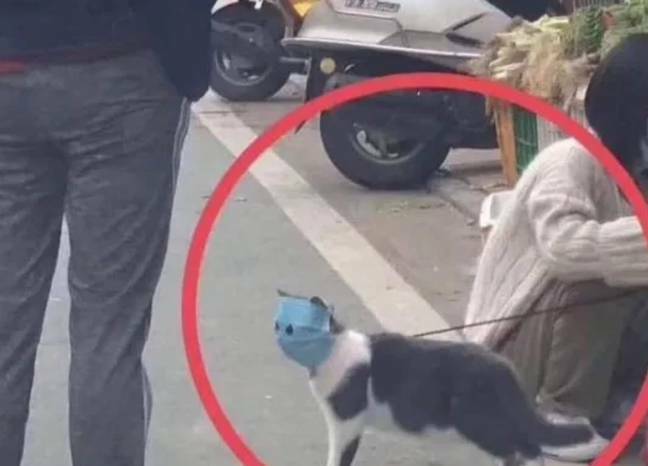A cat in China has been pictured wearing a makeshift mask to protect it from the coronavirus.
Pictures circulating on social media show the feline staring through two eye holes that have been cut into the human-sized surgical mask.
It is not clear whereabouts the pictures originate from, but while they are somewhat cute and amusing, it would seem the novel mask almost definitely serves no actual function.
First of all, the World Health Organization (WHO) has said there is no evidence that animals can be infected with the new coronavirus.
 Secondly, face masks are not thought to be very effective in protecting people – let alone cats. This is primarily because they are too loose, don’t cover the eyes and can’t be worn for extended periods. What’s more, they need to be changed frequently as they become sweaty, damp and futile.
Secondly, face masks are not thought to be very effective in protecting people – let alone cats. This is primarily because they are too loose, don’t cover the eyes and can’t be worn for extended periods. What’s more, they need to be changed frequently as they become sweaty, damp and futile.
Speaking to the BBC, Jonathan Ball, professor of molecular virology at the University of Nottingham, said: “In one well controlled study in a hospital setting, the face mask was as good at preventing influenza infection as a purpose-made respirator.
“However, when you move to studies looking at their effectiveness in the general population, the data is less compelling – it’s quite a challenge to keep a mask on for prolonged periods of time.”
So yeah, that cat mask probably ain’t doing much, other than making the furry fella look a little daft.
Other supposed preventative measures that have no basis in science include eating garlic, gargling mouthwash and rinsing your nose with saline.
The NHS advises that the best way to minimise your chances of catching viruses is to regularly and thoroughly wash your hands, avoid touching your eyes and nose and to live a healthy and active lifestyle.
Yesterday (Tuesday), the novel coronavirus was officially given the name Covid-19.
Technically, the virus already had the name ‘2019-nCoV’, but it wasn’t exactly the catchiest of titles, so understandably people have just been saying coronavirus instead.
 2019-nCov was also only ever supposed to be a temporary name recommended by the WHO, referring to the year it was discovered, the fact that it’s new or novel and that it’s a type of coronavirus.
2019-nCov was also only ever supposed to be a temporary name recommended by the WHO, referring to the year it was discovered, the fact that it’s new or novel and that it’s a type of coronavirus.
Speaking about the virus to Wired, Dr. Seema Yasmin said: “It seems a little bit different to what we saw with SARS back in 2002, where people were more likely to have sore throats, a runny nose and diarrhoea.
“There’s already evidence that this new coronavirus does spread from person to person. The interesting thing is it seems to be more infectious than SARS, another coronavirus, but less deadly.
“So at the moment we think that the death rate from the new coronavirus is around 2.5 to 3.5 percent – for SARS it was in the double digits; it was at least 10 or 11 percent.”



